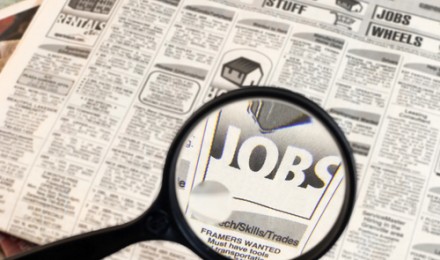The U.S economy was dealt a surprise with the latest Employment Situation (unemployment numbers) release showing that employers hired just 169,000 new workers for August. In addition, the Department of Labor (DOL) discovered that substantially fewer jobs were created in July than the 162,000 it originally reported. DOL revised the figure down to 104,000—the lowest number of new hires for any month in more than a year.
For the past three months, companies have added an average of 148,000 new positions. Both numbers fall significantly below the monthly average of 184,000 established over the past 12 months.
Furthermore, most of the new jobs resulted from more hiring in the lower-paying sectors of the economy. Continuing in a trend that commenced at the start of the year, bars and restaurants created 27,000 positions and retail establishments added 44,000 people jobs. Temporary agencies increased hiring with 13,000 jobs.
After five straight months of declines, manufacturing added 14,000 jobs, but construction hiring remained flat for August.
The demand for new automobiles has reached the highest level since the beginning of the last recession—December 2007.The automobile industry added jobs in August, but most of the increase comes from workers that were rehired from the temporary summer layoff, which occurs every year, to retool their factories.
Unemployment rate decreases
In August, U.S. factories expanded at the fastest pace in more than two years, according to the DOL. The unemployment rate dropped to its lowest level in five years at 7.3 percent. The problem is that data show the declined has more to do with more Americans stopped looking for work.
The long-term unemployed—defined as persons who have been without work for 27 weeks or more, remains the same at 4.3 million and makes up about 37 percent of the unemployed.
This figure has dropped by about 733,000 over the past year. The Employment Situation release states that individuals who are employed part-time because they could not find full-time employment or had their hours cut fell by 334,000 to 7.9 million
Fed bond buying program
With fewer jobs being created by employers, the Federal Reserve could decide to delay scaling back its $85 billion a month bond buying program. The program, which was started by the Fed in late 2008, puts more liquidity into the market by purchasing Treasury instruments and mortgage-backed securities. The program has been instrumental in keeping mortgage rates and other interest rates at extremely low levels.
For the policy to work, it depends on consumers and businesses borrowing borrowing money to spend and invest and help the economic recovery coming out of the recession, which ended June 2009. Consumer spending, which makes up70 percent of the domestic economy, has performed its part. American companies have not been as eager to hire more workers.
A little more than a month ago, Chairman Ben Bernanke announced that the Fed might begin to scale down the program later in 2013 and eliminate it by the middle of next year. The Federal Reserve will make know it intention for the bond buying program after the conclusion of its mid-September meeting.
The U.S economy was dealt a surprise with the latest Employment Situation (unemployment numbers) release showing that employers hired just 169,000 new workers for August. In addition, the Department of Labor (DOL) discovered that substantially fewer jobs were created in July than the 162,000 it originally reported. DOL revised the figure down to 104,000—the lowest number of new hires for any month in more than a year.
For the past three months, companies have added an average of 148,000 new positions. Both numbers fall significantly below the monthly average of 184,000 established over the past 12 months.
Furthermore, most of the new jobs resulted from more hiring in the lower-paying sectors of the economy. Continuing in a trend that commenced at the start of the year, bars and restaurants created 27,000 positions and retail establishments added 44,000 people jobs. Temporary agencies increased hiring with 13,000 jobs.
After five straight months of declines, manufacturing added 14,000 jobs, but construction hiring remained flat for August.
The demand for new automobiles has reached the highest level since the beginning of the last recession—December 2007.The automobile industry added jobs in August, but most of the increase comes from workers that were rehired from the temporary summer layoff, which occurs every year, to retool their factories.
Unemployment rate decreases
In August, U.S. factories expanded at the fastest pace in more than two years, according to the DOL. The unemployment rate dropped to its lowest level in five years at 7.3 percent. The problem is that data show the declined has more to do with more Americans stopped looking for work.
The long-term unemployed—defined as persons who have been without work for 27 weeks or more, remains the same at 4.3 million and makes up about 37 percent of the unemployed.
This figure has dropped by about 733,000 over the past year. The Employment Situation release states that individuals who are employed part-time because they could not find full-time employment or had their hours cut fell by 334,000 to 7.9 million
Fed bond buying program
With fewer jobs being created by employers, the Federal Reserve could decide to delay scaling back its $85 billion a month bond buying program. The program, which was started by the Fed in late 2008, puts more liquidity into the market by purchasing Treasury instruments and mortgage-backed securities. The program has been instrumental in keeping mortgage rates and other interest rates at extremely low levels.
For the policy to work, it depends on consumers and businesses borrowing borrowing money to spend and invest and help the economic recovery coming out of the recession, which ended June 2009. Consumer spending, which makes up70 percent of the domestic economy, has performed its part. American companies have not been as eager to hire more workers.
A little more than a month ago, Chairman Ben Bernanke announced that the Fed might begin to scale down the program later in 2013 and eliminate it by the middle of next year. The Federal Reserve will make know it intention for the bond buying program after the conclusion of its mid-September meeting.







